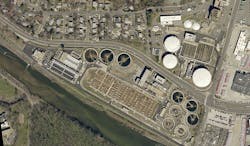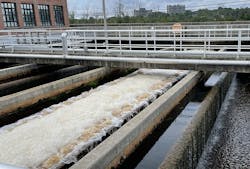WWTP Design and Innovation Improves Chesapeake Bay with Denitrification
Originally constructed in 1937, the Water Pollution Control Plant (WPCP) in South Arlington, Va., was upgraded in 2010 to address several long-term challenges: population growth, aging infrastructure, insufficient treatment capacity to handle increasing wet weather events and rising demand for environmental protection of and mitigation for the Chesapeake Bay watershed. Additionally, site space constraints would make the huge construction effort even more challenging.
The WPCP selected the collaborative team of De Nora Water Technologies, Malcolm Pirnie (the water division of ARCADIS) and Fru-Con Construction Company to execute a forward-thinking design and construction of an innovative wastewater treatment plant that would solve all known challenges while contributing to a cleaner watershed. The team completed the project within budget, and major components were completed approximately 18 months ahead of schedule, despite a compact, exceptionally challenging site hemmed in by residential and commercial development, roadways, overhead power lines and the Four Mile Run waterway.
The resulting planning, design and construction project was a $568 million, decade-long upgrade of the WPCP that expanded the plant’s capacity from 30 mgd to 40 mgd while also reducing nitrogen and phosphorous to the “limit of technology” in advance of environmental regulatory requirements. The upgrade included pushing the plant's biological nutrient removal capability of 8 mg/l total nitrogen to 3.0 mg/l with a concurrent low total phosphorous limit of 0.18 mg/l.
At the center of the denitrification process is the DE NORA TETRA® filtration system, a fixed-film biological denitrification process that also serves as a deep bed filtration system capable of removing oxidized nitrogen (NOx-N), total phosphorous (TP) and suspended solids (SS) to meet a high standard of effluent discharge. DE NORA TETRA Denite® is a single treatment solution that addresses multiple wastewater treatment plant process needs by offering a small, economical footprint and virtually maintenance-free operation.
In the 10 years since the construction on the project was complete, the plant continues to keep nitrogen and phosphorous effluent into the Four Mile Run stream well below target and regulatory levels. Using a highly effective filtration system that stays clean in large part through automated backwash processes, innovations such as using site-captured methanol to reduce effluent nitrogen and system design that includes the flexibility and scalability to handle regular heavy wet weather events as effectively as normal flow, the Arlington County WPCP reports nitrogen effluent to below 2.0 mg/l, down from a 1985 level of 19.5 mg/l; and phosphorous levels below 0.1 mg/l. These levels are significantly lower than the target levels of 3.0 mg/l for nitrogen and 0.18 mg/l for phosphorous. As a significant tributary to the nation’s largest estuary – Chesapeake Bay – reduction of nitrogen and phosphorous into Four Mile Run stream is helping to protect the health of this ecosystem.
Editor's Note: Scranton Gillette Communications and the SGC Water Group are not liable for the accuracy, efficacy and validity of the claims made in this piece. The views expressed in this content do not reflect the position of the editorial teams of Water & Wastes Digest, Water Quality Products and Storm Water Solutions.

